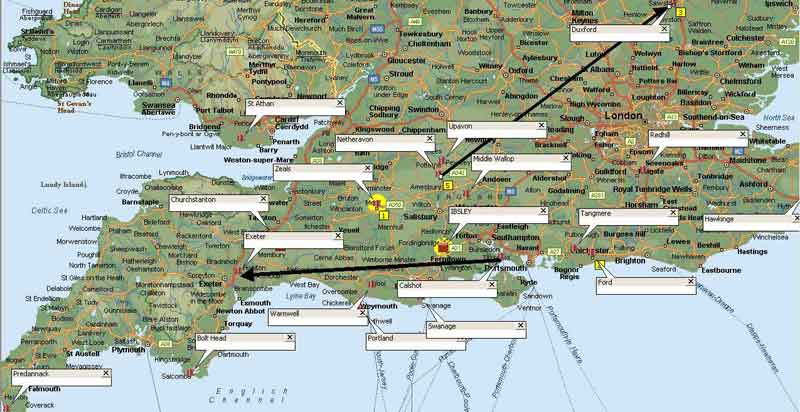
Airfields and significant locations for 118 Sqn during WWII.
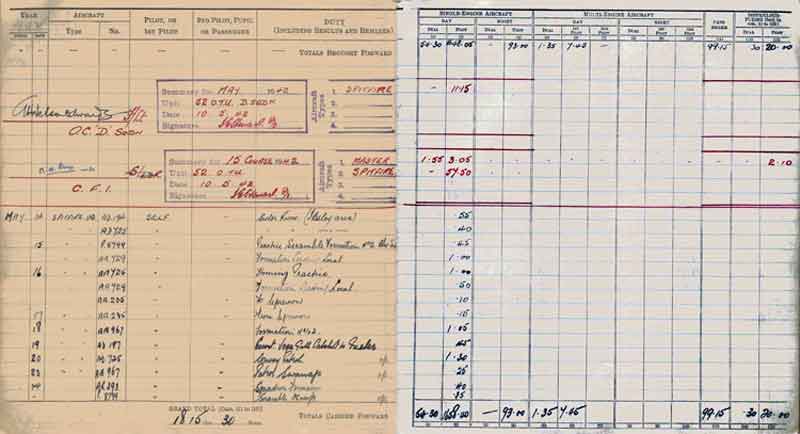
This is the first page of the logbook of Flying Officer Ian Gordon Stewart showing that he completed No 15 Course at 52 Operational Training Unit on the 10th May 1942 having flown a total of 57 hrs 50 mins in the Spitfire (Unknown mark) and 5 hrs on the Miles Master, of which there was 2 hrs 10 minutes instrument flying. In the last month, May 1942, he had flown 11 hrs 15 mins solo in the Spitfire. His total experience was 1,795 hrs 35 mins in single-engined aircraft and a further 9 hrs 20 in multi-emgined aircraft. A total of 1,804 hrs 55 mins experience. It is interesting to note that the OC D Sqn was Flt Lt Nelson-Edwards, a very famous name in later years.
He flew two Sector Recces on his first day on 118 Squadron on Thursday 14May42 in Spitfire VBs. The next day, Friday 15th he did a practice scramble in formation as a number 2 and practiced leading a local formation. On Saturday 16th May he practiced Homing to the airfield for one hour, (presumably using local radio aids to help him return to base in poor weather), and after another 50 mins leading a local formation, he flew over to their satellite airfield at Upavon and back again on the next day Sunday 17May42.. On Monday 18May he spent an hour and five minutes practicing formation flying as a No 1 and No 2. On Tuesday 19May he flew for 45 minutes escorting a light aircraft, the Vega Gull, from Calshot to Exeter, (probably because it had a VIP on board?). By Wednesday 20th May 1942 he completed his first operational sortie of one and half hours convoy escort. On Saturday 23rd May he patrolled Swanage for 25 minutes and the next day, Sunday 24th he practiced squadron formation flying and then had an operational scramble.
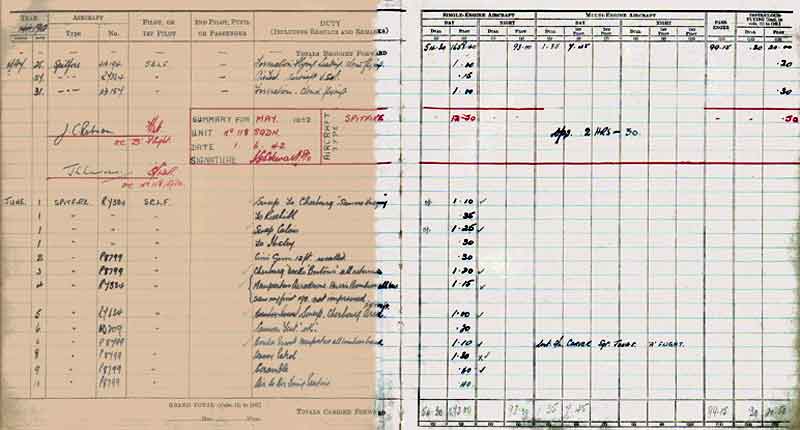
This next page from Ian's logbook finishes his flights in May 1942. It records that he completed two one hour sories on Monday 25th May 1942 and Sunday 31st practicing formation flying in cloud. In between on Wednesday 27May he did an airtest on Spitfire RY384(?)and declared the aircraft Satisfactory. His summary for May42 was signed by B Flight Commander Flt Lt Robson DFC and counter-signed by the Squadron Commander Squadron Leader Carver DFC. In May 42 Ian completed 12 hours 50 minutes in the Spitfire of which two and half hours were operational.
The 1st June 1942 was a Monday and Ian flew 4 trips. An operational sweep to Cherbourg of 1 hour and 10 minutes then a deployment to Redhill for a sweep of 1 hr 25 mins to Calais, ending with a return to Ibsley - all in Spitfire VB RY384 which looks as if it had become "his" Spitfire. It looks as though he was recalled after only 30 mins on Tuesday 2nd June, but the next day he was able to escort the Bostons on a successful raid on Cherbourg Docks when they all returned OK. On Thursday 4th June he escorted a bomber raid on an enemy aerodrome and records that he saw his first Focke Wolf 190, (described below), and was "not impressed".
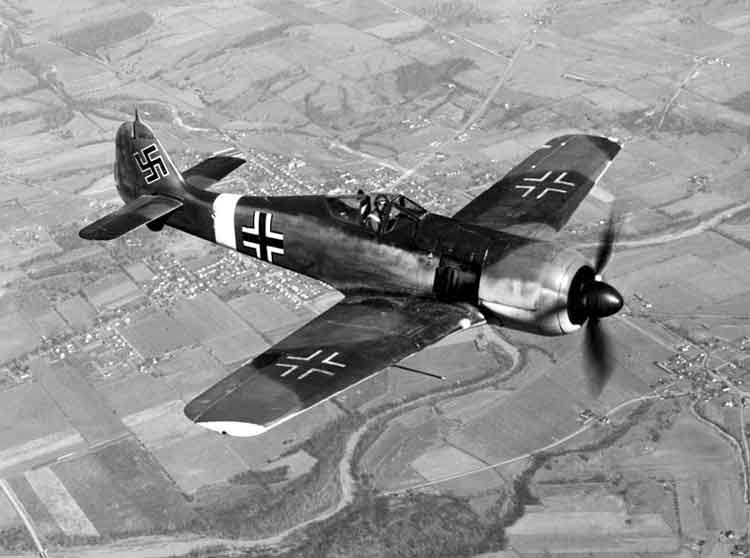
Focke-Wulf Fw-190
The Focke-Wulf Fw-190 stemmed from a suggestion by the German Air Ministry in 1937 that the company should develop an interceptor fighter to complement the Bf 109. Instead of opting for the Daimler Benz DB601 in-line engine, already in production for the Bf 109, Kurt Tank (Focke-Wulf's technical director) chose the BMW type 139 18-cylinder radial, which was still in the development stage. Three prototypes were built, the first of which flew on 1 June 1939. Apart from some emgine over-heating problems the flight tests went very well, and construction of the other protoypes was accelerated. The fifth Fw 190 was re-engined with the new 1,238 Kw (1,660 hp) BMW 14-cylinder 801C-0 engine, and this met all the Luftwaffe requirements. Its success led to the construction of 30 pre-production aircraft designated Fw 190A-0, these being followed by the Fw 190A-1, which went into service with JG26 at Le Bourget, Paris, in August 1941.
The Fw 190A-1 was followed into production by the A-2 (426 built), with a longer wing span and heavier armament, and 509 A-3 fighter-bombers. The next variant, the Fw 190A-4, of which 494 were built, had methanol-water power-boost system. The A-5 was a development of the A-4, with the engine re-located 0.15m (5.9 in) further forward, which restored the centre of gravity to the position it had occupied before it was moved by the addition of extra equipment in the rear of the fuselage; 723 aircraft were delivered, and undertook a variety of roles including assault, night-fighting, torpedo-bomber and bomber destroyer. Some A-5s were modified as two-seat Fw 190S-5 trainers , the S denoting Schulflugzeug (training aircraft). The Fw190A-6 , of which 569 were built, was a version of the Fw 190A-5/U10 fighter with lightened wing structure and fixed armament of four 20mm (0.79 in) cannon.
There was a number of A-6 sub-variants, one being a fighter-bomber with provision for 1,000 Kg (2,205 lb) of bombs, and others being bomber-destroyers with 30mm (1.18 in) cannon and extra armour to protect the pilot in head-on attacks. The Fw 190A-7, which entered production in December 1943, had a revised armament of two 20nn (0.79 in) cannon in the wing roots and two 12.7mm (0.50 in) machine guns in the forward fuselage. Only 80 aircraft were built before it was supplamnted by the Fw 190A-8, the last new-build variant of the Fw 190A series. Total production was 1,334 aircraft. The A-8 was fitted with a nitrous-oxide power-boost system and an extra fuel tank in the rear fuselage. Some were converted to the training role with the designation Fw 190S-8.
The next major production version, the Fw 190D, had a lengthened nose accommodating a 1,325 KW (1,776 hp) Junkers Jumo 213A-1 engine, liquid-cooled unit fitted with an annular radiator duct that gave it a radial-engined appearance. The aircraft also had a lengthened rear fuselage. The first major production model was the Fw 190D-9 interceptor, which entered service with JG-3 in 1943. The Fw 190G was a long-range attack variant which was followed, out of sequence, by the Fw 190F fighter-bomber, which was basically an Fw 190A-5 airframe with strengthened landing gear, more armour protection, and a combination of one ETC 501 bomb rack under the fuselage and four ETC 50 bomb racks under the wings. Specifications apply to the Focke-Wulf Fw 190A-8.
Crew: 1; Powerplant: one 1,575 KW (2,100 hp) BMW 801D-2 radial engine with water-methanol boost; Performance: max speed 654 Km/h (406 mph); range 1,470 Km (915 miles) service ceiling 11,400 m (37,402 ft) Dimensions: wingspan 10.50 m(34 ft 5 in); length 8.84 m (29 ft); height 3.9 m (13 ft). Weight: 4,900 Kg (10,802 lb) loaded. Armament: two 7.92 mm (0.31 in) machine guns in nose, and up to four 20mm (0.79 in) cannon in wings; provision for wide range of under-fuselage and under-wing bombs and RPs.
He spent an hour on a sweep in the Cherbourg area on 5th and after a Cannon test which was OK on Spitfire 309 he successfully escorted all bombers back from a sortie on Saturday 6Jun. On Monday 8Jun42 he spent 1 hr 30 mins on Convoy Patrol. There was a 40 minute scramble on Tuesday 9th followed by air to air firing practice on Wednesday 10Jun42.
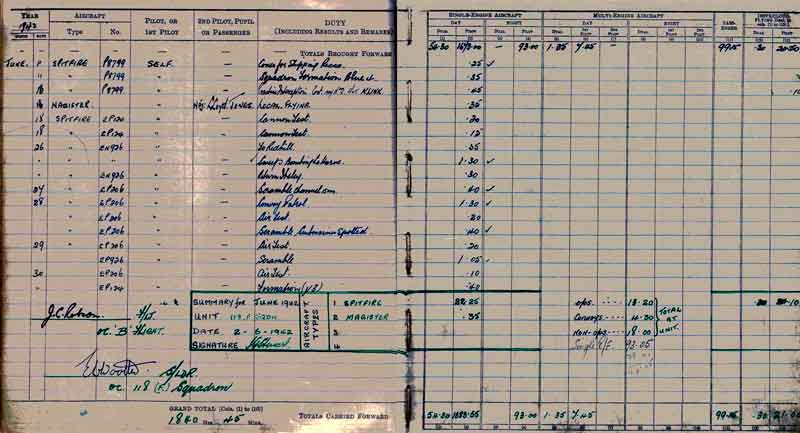
The month continued with a sortie providing cover for shipping convoy reconaissance and then a squadron formation checkout on 11Jun42. On 16Jun42 he carried out a practice interception with Sub. Lt. Klink as his number 2. On the same day he took Major Lloyd-Jones for 35 minutes in the local area in the Miles Magister. He twice tested the cannons on Spitfire EP124 on Thursday 18Jun42. During this period the squadron lost 4 pilots on one day, Saturday 20Jun42 over France. On Friday 26Jun42 he flew over to Redhill and took part in a bombing sweep over La Havre, before returning to Ibsley the same day. On Saturday 27Jun42 he was scrambled over the Channel at 15,000 ft. and on Sunday flew a convoy patrol. On the same day, after an air test of Spitfire EP206, he was scrambled in that aircraft when a submarine was spotted. There was another air test and scramble in EP206 on Monday 29Jun42 and a further air test of the same Spitfire the next day. The last trip of the month was on Tuesday 30Jun when he led a formation of 3. He flew a total of 22hrs 25 mins in the Spitfire in June 1942 and 35 mins in the Miles Magister. He noted that he had 93 hrs 5 mins experience of single engined flying and whilst on 118 Sqn had so far flown 13 hrs 20 mins operational flying of which 4 hrs 30 mins were on convoy escort and a further 18 hrs non-operational flying. His total flying time at this point was 1,840 hrs 45 mins. [Web master notes with interest that at that number of flying hours he had been flying in the RAF for 9 years and was halfway through his third tour as instructor on Jet Provosts at CFS.] It is sad to note that Ian's original CO Sqn Ldr Carver had been killed near Cherbourg on 9Jun42 and the new CO 'Bertie' Wooten has signed his logbook this month.
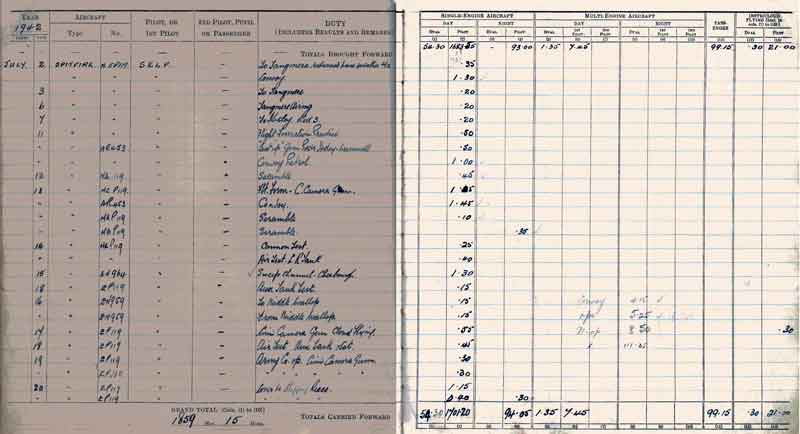
July 1942 began with an attempted trip to Tangmere which had to be aborted due to bad weather but he was able to complete an hour and half sortie on convoy escort. On Friday 3rd July 1942 he flew to Tangmere and on Monday 6Jul42 he took part in what looks like "Tangmere Airing" - maybe this was air to air firing? He returned to Ibsley the next day on Tuesday 7th in a formation as Red 3. On Saturday 11th he did 50 minutes Flight Formation practice. He then had a 50 minute trip "beating up" the gun positions at Ibsley and Warmwell, presumably for the benefit of exercising the gunners. The 11th ended with an hour long convoy patrol. He was scrambled for a 45 min flight on Sunday 12Jul42. On Monday 13th he had a 1 hour 45 min flight doing flight formation and it looks like cine camera gun practice. There followed two scrambles, the first only 10 minutes but the second was so late that he logged 35 mins night flying. [This may have been only one scramble that was entered on two lines to separate the night flying part of the trip?] On Tuesday 14th he had a 25 minute flight to test the cannons in EP119 followed by a 40 minute air test of the long range fuel tank. Wednesday 15Jul42 started with a one and half hour sortie on Channel sweeps near Cherbourg. The second flight of that day was to test the auxiliary fuel tank on EP119. On Thursday 16th he flew to and from Middle Wallop. Friday 17Jul42 there was only one trip of 55 mins doing cine camera gun practice and cloud flying. Saturday 18th involved another air test of the auxiliary fuel tank on EP119 and this was found to be satisfactory. Sunday 19th there were two army co-operation flights using the gun's cine camera. Monday 20Jul42 was taken up with two long sorties providing cover for the shipping reconnaissance flights.
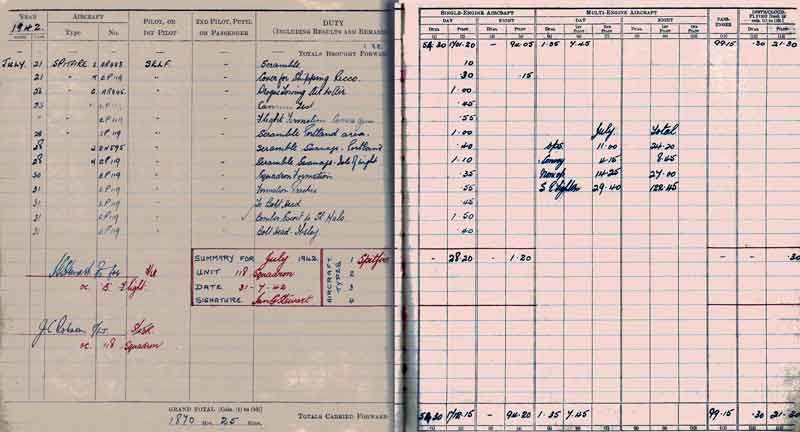
On Tuesday 21Jul42 he was airborne for 10 mins on a scramble and then 45 minutes providing cover for shuipping recces of which 15 mins was at night. On Thursday 23rd he towed a drogue for air to air firing practice for one hour. On saturday he air tested the cannons on EP119 again before a 55 minute trip practicing flight formation flying and did some gun camera work. On Tuesday 28Jul42 he had three scrambles, Portland area, Swanage and Portland and Swanage and the Isle of Wight. On Thursday there was 35 minutes practicing squadron formation flying with a further 55 minutes the next day. On the last day of the month, Friday 31Jul42, he deployed to RAF Bolt Head and from there mounted a 1 hour 50 minute sortie escorting bombers to St Malo before returning to Ibsley at the end of the day. He had flown 28.20hrs in the Spitfire in July 1942 with a further 1 hour 20 logged at night. He had spent 11 hours total on Ops of which 8hr 45 mins were convoy escort and a further 14.25 non-operational flying. This brought his total hours up to 122.45 on single-engined fighters with a total flying time of 1,870.25 hrs. His logbook summary for Jul 1942 was signed off by Flt Lt Robson acting for the Squadron Commander.
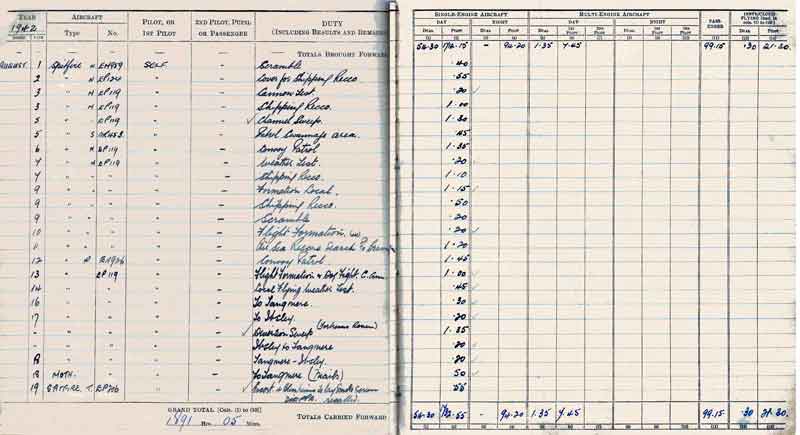
August 1942 began with a scramble for a 40 minute trip on Saturday 1st. On the Sunday he flew a 55 minute sortie providing cover for shipping reconnaissance. On Monday 3Aug42 he tested the cannons on EP119 and then flew a one hour shipping recce sortie. There were two sorties on Wednesday 5th, one hour thirty minutes on a channel sweep and a 45 minute patrol over the Swanage area. There was just a one hour thirty five minute convoy patrol on Thursday 6th. After a weather test on Friday 7th he flew a one hour ten minute shipping reconnaissance sortie. He next flew on Sunday 9th for a one hour fifteen minute local formation practice, followed by another shipping recce and finally a 20 min scramble. On Monday 10Aug42 he flew only a formation practice but the next day he flew an air-sea rescue sortie looking for Plt Off Bramley?( or Bramage). Wednesday 12th saw another 1.45 convoy patrol. On Thursday 13th he flew a formation practice flight which also involved a practice "dog fight" using the cine gun camera. Friday 14th was only a 45 minute weather test. On Saturday 16Aug42 the whole wing deployed to Tangmere in preparartion for covering the Dieppe raid - Operation Jubilee (Click to see more: http://en.wikipedia.org/wiki/Operation_Jubilee_order_of_battle ".) On Sunday 17th he flew back to Ibsley and took part in a diversionary sweep against Fortress Rouen, finally returning to Tangmere. On Monday 18th Ian flew two trips, one by Spitfire back to Ibsley so that he could to bring back the mail flying the Moth. On Tuesday 19th he flew from Tangmere in EP206 providing support for 4 Blenheims which were to lay a smoke screen for the Dieppe operation but it looks as though this was recalled and lasted only 55 minutes. By the end of that page he now had a total of 1,891.05 hours experience.
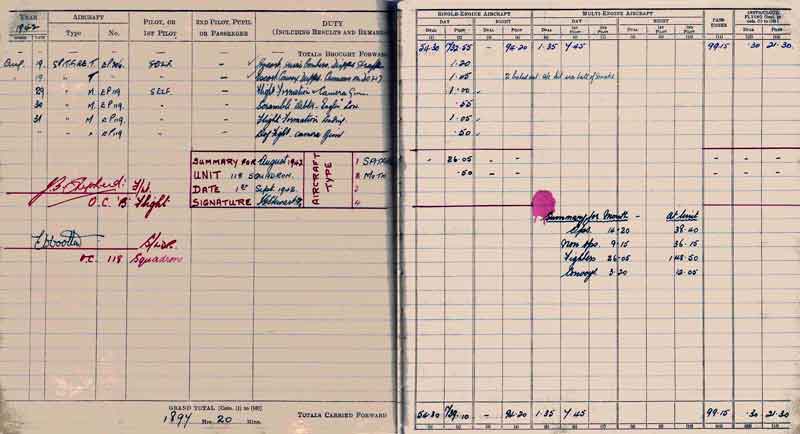
During a second sortie on the 19th he escorted Hurricane bombers and straffed Dieppe as part of the large amphibious operations that was going on there. On the last sortie of that day, when he was escorting convoys covering the withdrawal at Dieppe, he fired his cannons on a Dornier Do217 (described below), and saw two German crew bale out and the aircraft hit the sea in a ball of smoke. The 118 Sqn history records this as a kill shared with Flt Lt Shepherd, (his Flight Commander who received a DFC, "C" in picture below), and Flt Sgt Watson ("I" in picture below.)

The Dornier Do 217 was a bomber used by the German Luftwaffe during World War II as a more powerful version of the Dornier Do 17, known as the Fliegender Bleistift (German: "flying pencil"). Designed in 1937 and 1938 as a heavy bomber but not meant to be capable of the longer-range missions envisioned for the June 3, 1936-dated Bomber A contract winning Heinkel He 177, the Do 217's design was refined during 1939 and production began in late 1940. It entered service in early 1941 and by the beginning of 1942 was available in significant numbers. The Dornier Do 217 had a much larger bomb load capacity and had much greater range than the Do 17. In later variants, dive bombing and maritime strike capabilities using glide bombs were explored in depth, with considerable success in the latter role. Early Do 217 variants were more powerful than the Heinkel He 111 and Junkers Ju 88, having a greater speed, range and bomb load. Owing to this it was designated a heavy bomber rather than a medium bomber. The Do 217 served on all fronts in all roles. On the Eastern Front and Western Front it operated as a strategic bomber, torpedo bomber and reconnaissance aircraft. It also performed tactical functions, either direct ground assault or anti-shipping strikes during the Battle of the Atlantic and Battle of Normandy. The Do 217 was also converted to become a night fighter and saw considerable action in the Defense of the Reich campaign until the last day of the war. The type also served in anti-shipping units in the Mediterranean, attacking Allied convoys and naval units during the Battle of the Mediterranean. It was in the Mediterranean that the Do 217 became the first aircraft in military aviation history to deploy a form of precision-guided munition in combat, in the form of the Fritz-X radio-guided, free-fall bomb, which led to the sinking of the Italian battleship Roma in 1943. After the end of the war, at least one Dornier Do 217 continued in active military operational service with the Swiss Air Force until 1946. Specifications apply to the Do217E. Crew: 4; Powerplant: two 1,179 KW (1,580 hp) BMW 801ML 14-cylinder radial engines; Performance: max speed 515 Km/h (320 mph); range 2,800 Km (1,740 miles) service ceiling 9,000 m (29,530 ft) Dimensions: wingspan 19.00 m (62 ft 4 in); length 18.20 m (59 ft 8.5 in); height 5.03 m (16 ft 6 in). Weight: 16,465Kg (36,299 lb) loaded. Armament: one 15 mm (0.59 in) cannon; two 13 mm (0.51 in) and three 7.92 mm (0.31 in) machine guns; bomb load of 4,000 Kg (8,818 lb); two Hs 293 or Fritz-X anti-shipping missiles. (Thanks to The Encyclopedia of Aircraft edited by Robert Jackson and to Wikipedia.)
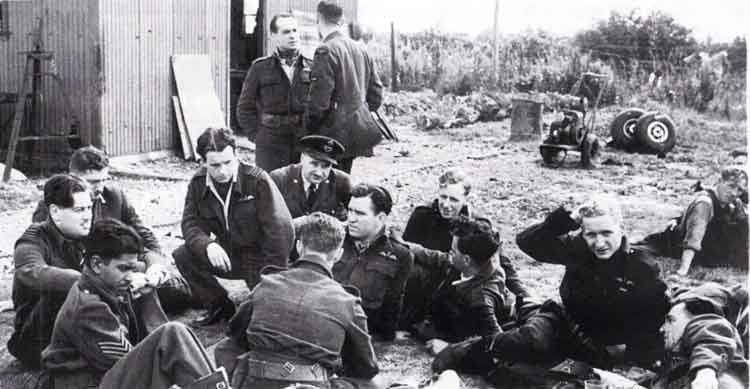
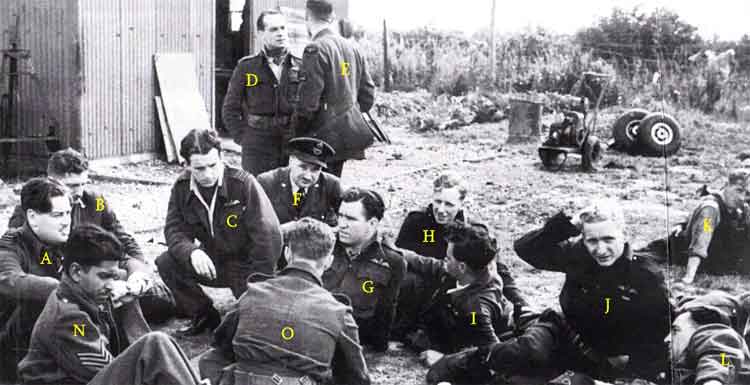
118 Sqn in dispersal at Tangmere where they were deployed for Operation Jubilee, the Raid on Dieppe. This is believed to have been taken as they were waiting to cover the withdrawal on 19/20th August 1942. Notice the sidearms of some of the pilots. The CO Sqn Ldr Bertie Wootton ("A") is sitting on the extreme left and Jimmy Talalla ("N") in front of him. (Click to see full report in 118 Squadron History.) L to R: A. CO Sqn Ldr Bertie Wooten, B. Unknown, C. F/L Shepherd, D. Unknown, E. Unknown, F. Henry Mallory Sqn Adj, G. F/L Dickie Newbury, H. Unknown, I. Sid Watson,
J. Unknown, K. Unknown, L. Unknown, N. Jimmy Talalla. (Thanks to Wilf Crutchley.)
Ian next flew on Saturday 29Aug42 for some flight formation practice and some cine gun camera work. The next day, Sunday, he was scrambled for 55 minutes on what looks like "Debtor-Eagles" Low - whatever that may have meant? Can anyone explain the phrase? On Monday 31st August 1942 he flew two sorties in EP119, the first was for an hour and five minutes leading a formation and the second was a dog fight using the camera guns - presumably a practice. That completed his flying for August 1942 having flown for 26 hrs and 5 mins in the Spitfire and 50 minutes in the Tiger Moth. He flew 14.20 on operations bringing his operational hours up to 38.40. There was 9.15 on non-ops this month and 3.20 escorting convoys. He now had a total experience of 1,897 hrs and 20 mins. Note that his logbook was signed by his Flight Commander Flt Lt Shepherd and his CO Sqn Ldr Wooten.
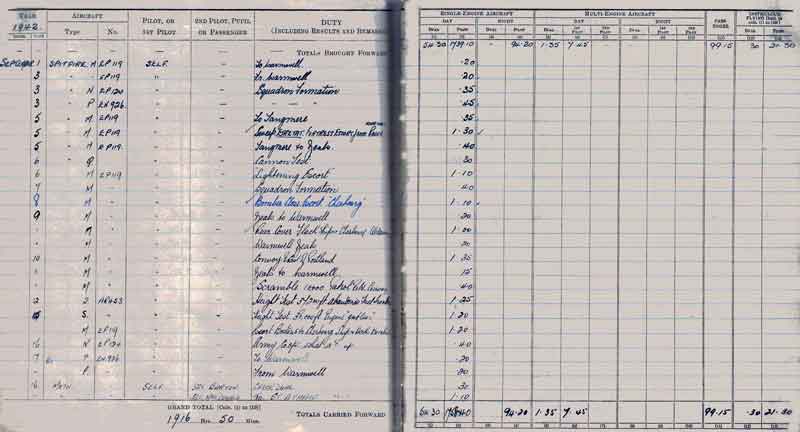
The 118 Squadron history tells us that by the end of August 1942, the Ibsley Wing had disbanded and 118 Sqn were redeployed to Zeals, West of Salisbury, this becoming their main operating base. On Tuesday 1Sep42 Ian flew his Spitfire to Warmwell, 28 miles South near Portsmouth, and returned 2 days later. After returning on Thursday he did two trips of practice formation flying. He deployed to Tangmere on Saturday 5th and from there flew a sweep sortie providing successful escorts for the Fortresss from Rouen as none were lost. On the last trip of that day he flew back to Zeals. From there on Sunday 6Sep42 he tested the cannons on Spitfire Q before flying as escort for the Lightnings in EP119 for 1 hour and 10 mins. On Monday he flew a practice Squadron formation sortie. On Tuesday 8Sep42 he provided close bomber escort on a raid to Cherbourg. After moving back to Warmwell the next day, he flew rear cover for the flak ships over Cherbourg and then flew back to Zeals. On Thursday 10th he flew a convoy escort over Portland lasting 1 hr 35 mins. Friday 11th saw another move to Warmwell from Zeals when he then flew on a scramble to 10,000 ft providing a patrol escort for a convoy. On 12th in AR453 he conducted a height test to 37,200 ft which had to be abandoned because of fuel shortage. Three days later on Tuesday 15Sep42 he flew another height test in AR453 and found the engine "gutless" at 38,000 ft. On the same day he flew for 40 minutes escorting the Bostons bombing Cherbourg ships and the docks. He was unimpressed by the Army Co-operation flight of 40 mins on 16th remarking "What a ... up!" On that Wednesday he checked out Sgt Barton in the Moth and then flew down to RAF St Athan, just outside Cardiff, with Sgt. MacDonald also in the Moth returning in the Magister on the same day.(see next page of logbook). On Thursday 17th he flew Spitfire EN926 to and from Warmwell. He now had a total flying time of 1,916.50hrs.
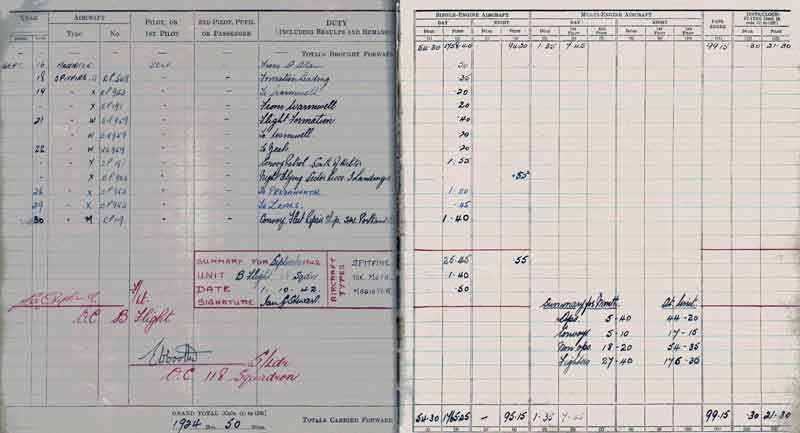
This page covers the closing days of September 1942. On Friday 18Sep42 Ian practiced formation leading for 35 mins from Zeals. On Saturday he flew to Warmwell in Spitfire EP953 returning to Zeals in EP191. The following Monday, 21st, he practiced Flight formation flying for 40 mins and then flew back to Warmwell in EN959. He flew W, EN959, back to Zeals on Tuesday 22nd and then mounted a convoy patrol south of a place that looks like "Dibtor"? Anyone know where that might be? He mentions the same name on 30Aug42 above. That evening he carried out 55 minutes of night flying practice consisting of a sector recce and 3 landings. On Saturday 26Sep42 he flew for 1 hour down to Predannack in Cornwall in EP953 Spitfre X-ray, (where 118 Sqn maintained a detachment), returning to Zeals the following Tuesday, 29th. On the last day of September 1942 he flew EP119 M covering a Fleet Repair Ship south-west of Portland. His Monthly Summary shows that he flew 26 hrs 45 mins in the month of which there was 5.40 hrs on operational flying (5.10 on convoy support) and 18.20 hrs on non-operational flying. By this time he had a toatl number of flying hoursof 1,924.50 of which 176.30 hrs were in the Spitfire.
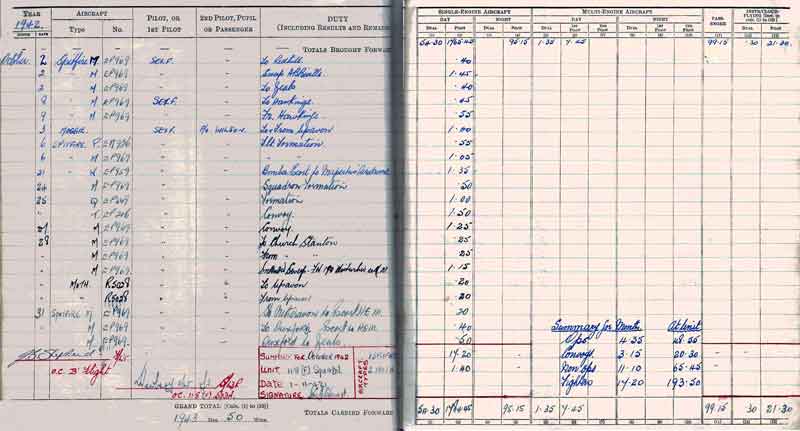
October's flying began on Friday 2nd with a deployment to Redhill from whence he flew a sweep over Abbeville before flying back to Zeals, ( all in what appears to be "his" Spitfire M EP119). The next day he took Fg Off Wilson to and from Upavon in the Miles Magister. On Tuesday 6th he did two trips practicing Flight formation flying. On Thursday 8th he did a another deployment but this time as far afield as Hawkinge in Kent just outside Folkstone. There were no sorties from there and he flew back the next day Friday 9Oct42 - 45 mins there and 55 minutes back. After a relatively long break (12 days) he flew a 1hr 35 min sortie escorting bombers that were attacking Maupertus airfield at Cherbourg on Wednesday 21Oct42. He flew Squadron formation practice on Saturday 24th and more formation practice on the Sunday finishing the weekend with a 1 hr 50 minute convoy escort sortie on the same day. He flew another 1 hr 25 min convoy escort on Tuesday 27th. He flew to and from Churchstanton by Spitfire on Wednesday 28th before taking part from Zeals in what was intended to be a sweep but which was interrupted by two Focke Wolfe 190s. At the end of a busy day he flew the Tiger Moth to and from Upavon. On Saturday 31st, the last day of October 1942, he had an interesting task. He flew to Netheravon and escorted a Heinkel He111, (described below), from there to Duxford before returning to Zeals, 1 hr 50 mins in Spitfire M EOP969.
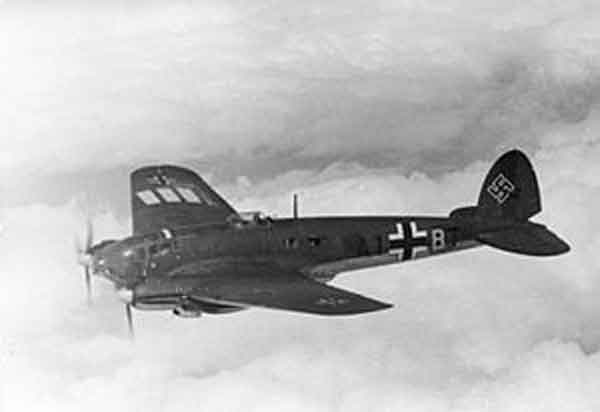
Heinkel He 111
The Heinkel He 111 was designed in 1934 as a high-speed transport and as a bomber for the still-secret Luftwaffe. The first protoype, the He 111A (later redesignated He 111 V1), flew for the first time on 24 February 1935, and was followed by the V2, which was to make its maiden flight on 12 March 1935.
This aircraft, D-ALIX, was a transport version witha reduced span and a straight trailing edge; it was delivered to Luft Hansa and named Rostock, and was later used for clandestine reconnaissance missions. The He 111 V3, D-ALES, was a bomber with a further reduced wingspan, and was the forerunner of the He 111A production model. Folowing the success of the He 111 V3, Heinkel was ordered to proceed with the construction of a pre-production batch of 10 He 111A-0s. Two aircraft were sent to Rechlin for trials; however they were found to be unsuitable for operational use because their handling characteristics were badly affected by the extra weight of military equipment. All 10 examples were shipped to China for use against the Japanese.
Meanwhile development of the civil transport series continued with the He 111 V4 D-AHAO, which was capable of carrying 10 passengers. It was delivered to Luft Hansa in January 1936 and was followed by six production Heinkel He 111C-0s, all named after German cities.
In the meantime, Heinkel had been working on a replacement for the He 111A-0 . This was the He 111B, which possessed two 746 KW (1,000 hp) Daimler-Benz DB-600A engines. The prototype was the He 111 V5 D-APYS. The aircraft was ordered into production for the Luftwaffe as the He 111B-1, with the first examples being delivered to L/KG 154 'Boelcke' at Hannover-Langenhagen late in 1936. In 1937 the He 111B-1 was tested under combat conditions with the Kondor Legion in Spain and proved very successful, its speed alone enabling it to evade fighter interception.
The 306 He 111Bs were followed by the He 111D, only a few of which were completed before production was switched to the He 11E bomber with Junkers Jumo engines and a small number of He 111Fs similarly powered, the latter being the first to feature a wing with a straight leading edge. These variants also saw service in Spain, and after the civil war they were taken over by the Spanish Air Force. The He 111G was another transport version, five examples being delivered to Luft Hansa and four to Turkey.
About 1,000 examples of all these He 111s variants had been produced by mid-1939, by which time a new model had made its appearance. This was the He 111P, which was powered by two 858 KW (1,150 hp) Daimler-Benz DB 601 Aa engines and which incorprated a fully glazed asymmetric nose with its offset ball turret, in place of the stepped-up cockpits of the earlier variants. Relatively few He 111Ps were completed before production switched to the He 111H, powered by two 821KW (1,100 hp) Junkers Jumo 211 engines.
Subvariants of this series were to form the backbone of the Luftwaffe's bomber force between 1940 and 1943, with about 6,150 being built before production ended in 1944. The first version of the type to carry torpedoes was the He 111H-6, followed by the He 111H-15. The He 111 scored some notable successes against the wartime Artic convoys to Russia, notably against the ill-fated PQ17 in July 1942, when the convoy was virtually destroyed. Specifications refer to the He 111H-16.
Crew: 5; Powerplant: two 1,007 KW (1,350 hp) Junkers Jumo 211F inverted V12 engines; Performance: max speed 436 Km/h (271 mph); range 1,950 Km (1,212 miles) service ceiling 6,700 m (21,980 ft) Dimensions: wingspan 22.60 m (4 ft 1 in); length 16.40 m (53 ft 9 in); height 4 m (13 ft 1 in). Weight: 14,000 Kg (30,865 lb) loaded. Armament: one 20 mm (0.79 in) MG FF cannon in nose, one 13mm (0.51 in) MG 131 gun in dorsal position, two 7.92 mm (0.31 in) MG 15 guns in rear of ventral gondola and two 7.92 (0.31 in) MG 81 guns in each of two beam posirtions; up to 2,000 Kg (4,409 lb) of bombs internally and a similar load externally. (Thanks to The Encyclopedia of Aircraft edited by Robert Jackson).
His summary shows that he flew 17.20 hrs in the Spitfire and he added all his hours, 1.40 hrs flown in both the Magister and the Tiger Moth, under the heading Moth. He logged 4.35 hrs on operational flying of which 3.15 hrs were convoy escort. His total non-operational flying for October 1942 was 11.10 hrs. He records that so far he has logged 48.55 hrs operational flying on 118 Sqn. His total experience is now 1,943 hrs 50 mins.
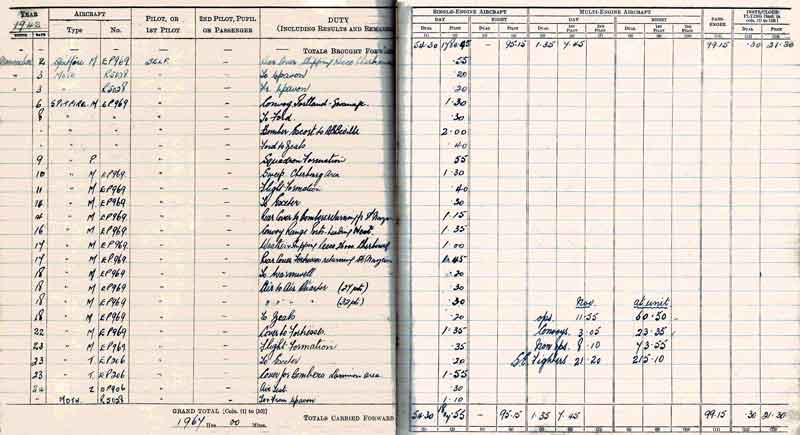
Ian's first day flying in November 1942 was on Monday 2nd when he provided rear cover for a shipping recce to Cherbourg. The next day, 3rd, he flew the Tiger Moth to and from Upavon. He was back in the Spitfire for Friday 6th with a convoy escort from Portland to Swanage. On Sunday 8th he flew Spifire M EP969 down to Ford on the South coast and from there provided a 2 hour bomber escort to Abbeville before flying back to Zeals at the end of the day. On Monday he had only some Squadron practice formation flying. On Tuesday 10th he flew a sweep in the Cherbourg area which took 1.30 hrs. On the 11th he just did some more Flight formation practice. On Saturday 14Nov42 he deployed to Exeter and then provided rear cover to fortresses returning from Saint Nazaire. Monday 16th he flew 1.35 hrs providing cover for convoys heading West from Portsmouth. The next day, 17th, he flew a weather and shipping recce at 26,000 ft over Cherbourg. On Wed 18th he deployed to Warmswell from where he flew two air to air firing quarter attack sorties of 30 mins each on which he scored 27 and 33 points before returning to Zeals. On Sunday 22Nov42 he flew 1.35 providing cover to the Fortresses. The next day he practiced Flight formation flying before deploying again to Exeter so that on the 23rd he could fly for nearly two hours escorting fortresses to the Larmion area. On Tuesday 24th he did a 30 min air test on Spitfire Z EP906 before flying the Tiger Moth to and from Upavon. His total operational flying for November 1942 was 11.55 hrs of which 3.05 were convoy escort. He now had 215.10 hrs on single-engined fighters and a total air time of 1,967 hours overall.
(Thanks to Ian's Grandson Alistair Stewart.)
|







